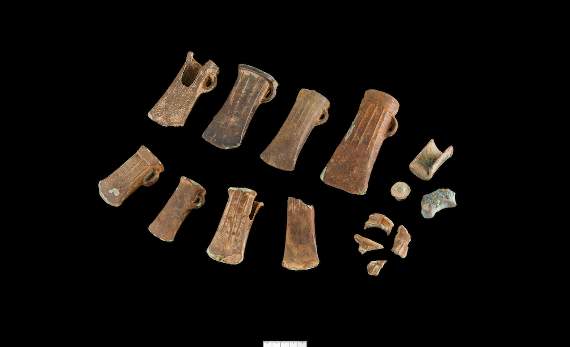TWO Bronze Age hoards found in Monmouthshire were declared treasure last Friday (18th August) by H.M. Coroner for Gwent.
The two hoards of bronze tools and weapons were discovered on the same day in January 2015 in Llantilio Crossenny in the same field, by a group of metal-detectors.
One hoard, discovered by Mr Lee Doyle, Mr Liam O’Keefe, Mr David Owen and Mr John Thomas, contained nine bronze socketed axes.
These may be dated to the Ewart Park phase of the late Bronze Age, around 3,000 years ago.
The second smaller hoard, discovered by Mr David Hughes, was found 135 metres away from the larger hoard. It comprises two bronze socketed axes and a bronze spearhead, of the same age as the larger hoard.
The discoveries were first reported to Mark Lodwick, the Portable Antiquities Scheme Cymru Co-ordinator and were subsequently reported on by museum archaeologists at National Museum Wales.
An archaeological investigation of the find-spot was undertaken by museum archaeologists in October 2015 with the help of the finders. This suggested that the two hoard groups had been buried in two separate pits in the ground. The hoards were located beside small stream channels.
Abergavenny Museum is keen to acquire these prehistoric finds for its collections following their independent valuation. It hopes to acquire the hoards with grant support provided by the Saving Treasures; Telling Stories funded via the Heritage Lottery Fund.
Rachael Rogers, Curator at Abergavenny Museum said: “We are really excited by these finds which contribute to the prehistoric story of the area. We look forward to them coming to Abergavenny Museum, so they can be cared for and enjoyed by our many visitors and users. The stories to be told from these objects will really help us to get a little closer to the people and communities who made and used them.”
Adam Gwilt, Principal Curator of Prehistory at National Museum Wales added: “These hoards contain a real variety of tools and weapons used towards the end of the Bronze Age in this region. Many whole and still usable bronze objects were carefully buried in the ground at this particular time and archaeologists now think that these may have been gifts to the gods and ancestors, buried during ritual ceremonies.
“It is curious that this place in the landscape was chosen for the burial of two hoards of the same date and very close to each other.”
Pictures are courtesy of National Museum Wales.

Comments
This article has no comments yet. Be the first to leave a comment.